juuni . 26, 2025 09:59 Back to list
Importance of Ovulation Prediction Test Kits
For women trying to conceive, understanding their fertile window is crucial. Ovulation test kit products have revolutionized family planning by making ovulation detection accessible and affordable. These fertility test for women work by identifying the luteinizing hormone (LH) surge that precedes ovulation, while modern ovulation detection kit options now offer digital readings and app connectivity. This comprehensive guide explores how these tests work, their benefits, and how to use them effectively for conception success.

The working mode of the ovulation test kit
The science behind ovulation test kit products is both simple and brilliant. These fertility test for women detect the sudden rise in luteinizing hormone (LH) that occurs 24-36 hours before ovulation. Most ovulation detection kit options use urine samples, though some advanced models now analyze saliva patterns or basal body temperature.
Standard ovulation test kit strips contain antibodies that react with LH. When hormone levels reach a certain threshold , a test line appears. Digital fertility test for women versions eliminate guesswork by displaying clear positive/negative results. The newest ovulation detection kit models sync with smartphone apps to track cycles and predict optimal testing times, creating a comprehensive fertility monitoring system.
Types of Ovulation Tests Kit
Today's market offers several ovulation test kit varieties to suit different needs and budgets. Basic strip tests provide affordable daily testing, while mid-range fertility test for women options might include 5-10 tests per package with easy-read results. Premium ovulation detection kit systems often feature:
Digital readers that eliminate line interpretation
Dual hormone detection (LH and estrogen) for wider fertile windows
Bluetooth connectivity to fertility apps
Reusable handles with disposable test sticks
Saliva-based ovulation test kit products use crystallization patterns that change with rising estrogen, while basal body temperature fertility test for women kits track the slight post-ovulation temperature rise. Understanding these differences helps women choose the right ovulation detection kit for their cycle characteristics and testing preferences.
The accurate time and method of fertility test for women
Proper timing dramatically affects ovulation test kit reliability. Most fertility test for women should be used in the afternoon when LH concentrations peak, unlike pregnancy tests that work best with morning urine. For regular cycles, testing typically begins 3-5 days before expected ovulation.
To maximize ovulation detection kit accuracy:
Test at consistent times daily
Limit fluids 2 hours before testing
Avoid first morning urine samples
Follow package instructions precisely
Track multiple cycles for pattern recognition
Women with irregular cycles may need to use ovulation test kit products more frequently or opt for fertility test for women that monitor multiple hormones. Some advanced ovulation detection kit systems now adjust testing recommendations based on previous cycle data.
The benefits of regularly using ovulation testing kit
Using an ovulation test kit provides numerous advantages beyond conception planning. These fertility test for women help identify:
Ovulation day for timing intercourse
Possible anovulatory cycles
Hormonal imbalances affecting fertility
The complete fertile window (not just ovulation day)
Modern ovulation detection kit products empower women with knowledge about their reproductive health. The data from consistent ovulation test kit use can also help healthcare providers evaluate potential fertility issues. Many fertility test for women now come with cycle tracking features that provide insights beyond just LH detection.
FAQs About Ovulation Test Kit
How accurate are ovulation test kit?
Quality ovulation test kit products are approximately 99% accurate at detecting the LH surge when used correctly. However, an LH surge doesn't guarantee ovulation will occur, making some fertility test for women combine multiple hormone detection for better prediction.
Can medications affect ovulation detection kit results?
Certain fertility drugs containing hCG or LH can cause false positives on ovulation test kit strips. Birth control pills may suppress ovulation, making fertility test for women unreliable until cycles regulate after discontinuation.
Why does my ovulation test kit never show positive?
Some women have subtle LH surges that basic ovulation detection kit products might miss. Switching to a more sensitive fertility test for women (detecting 20 mIU/mL instead of 40) or trying digital ovulation test kit options often helps.
How many days should I use fertility test for women kits?
Most women need 5-7 days of testing with an ovulation detection kit per cycle. Those with irregular cycles may require 10+ days of ovulation test kit use to catch their LH surge.
Do ovulation test kit expire?
Yes, fertility test for women kits typically expire 12-24 months after manufacture. Expired ovulation detection kit products may show inaccurate results due to antibody degradation in the test strips.
Modern ovulation test kit technology puts powerful reproductive insights directly in women's hands. Whether you're just starting to try for a baby or have been attempting conception for months, these fertility test for women provide valuable data about your cycle. The latest ovulation detection kit options with digital tracking and app integration make the process easier than ever.
Don't leave your conception timeline to chance—invest in your fertility knowledge today with clinically-proven ovulation test kit solutions. Our selection of premium fertility test for women includes options for every cycle type and budget. Take the first step toward understanding your body better and maximizing your chances of conception with reliable ovulation detection kit products designed for real results.

